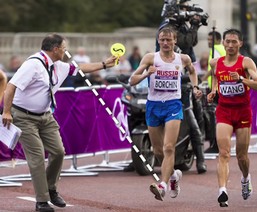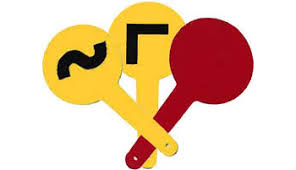Race walking rules
Race walking
race walking rules
The official definition is:
"Race walking is a progression of steps so taken that the walker makes contact with the ground so that no visible (to the human eye) loss of contact occurs"
This is really important if you want to take part in a Centurion qualifying race. Or, indeed any race which is designated a "judged" race walk.
Races in the UK operate under the rules of the race walking governing body - Race Walking Association (RWA) in conjunction with England Athletics and World Athletics (formerly the International Amateur Athletics Federation - IAAF).
This means that there has to be a certain number of qualified judges on the course over a 24 hour period. The judges themselves must have attained a certain standard of judging.
Most Centurion qualifying races are held under the auspices of their national athletics governing body, but note that not every country may apply these rules, so it it is always important to check the rules before you compete. This is especially important if you want to register any sort of race record.
World Athletics introduce new shoe rules (February 2021)
All competitions on the track, road and cross country held under the Rules are subject to the application of the rule to ensure fair competition and, should records be achieved, then those records can be ratified. WA will review the rule following the Tokyo Olympic Games.
UKA have produced a table below which shows the thickness of sole currently allowed across the complete range of athletics events. UKA World Athletics Shoe Rule FAQs April 2021
yes, it's always best to know the rules!
Race Walking is a technical sport with judges and rules which may often seem complex and confusing.
Basically, there are two categories of race walking races:
"A" race - national/international championship race rules
"B" race - domestic races
- the rules state that the straightening of knees shall not apply.
What you need to know:
Judges are positioned around the course to ensure everyone complies with the rules - ie walking and not breaking into a trot or run (the contact rule) and that the legs are kept straight...
Depending on the status of the race ie national, international, domestic .... this means the judges will be watching for:
- "contact", ie, one foot must be in contact with the ground at any one time (or words to that effect) and
- bent legs.
"cautions"
These rules must actually be visible to the naked eye.
Therefore, when a judge sees a walker in danger of breaking one of the rules, the judge may caution the walker before an official "card" is shown to the athlete.
The Centurion qualifying races usually operate under the rules of the race walking governing body in each country. Mostly the 100 miles is desigated a B race,
The "official" method of judging:
The duty of a Chief Walking Judge must organise the team of judges allocated to walks, whether on the track or on the road.
Secondly, the duty of each individual walking judge is to apply the rules of walking and method of judging to the walkers taking part.
How do athletes know they are trangressing the rules?

(1) A YELLOW "PADDLE" is a CAUTION, which is just that - advice to a competitor to be careful as they are in danger of breaching the rules.
This advice is given via a yellow "paddle" bearing one of two symbols: a squiggle ~ for loss of contact, or an arrowhead > for a bent knee.
This advice is given via a yellow "paddle" bearing one of two symbols: a squiggle ~ for loss of contact, or an arrowhead > for a bent knee.
A competitor can also receive YELLOW PADDLES from every judge on the course, but no more than two (one for each offence) from the same judge.
Note: The number of YELLOW PADDLES a competitor receives has no bearing on whether or not they have been reported to the Chief judge for actually breaking the rules. Yes, it's complicated.... but read on for the finer details.......
(2) A RED CARD is a silent communication between the on-course judges and the Chief judge. Which means that the athlete is not informed of any red card which has been issued.
A judge will issue a RED CARD if a competitor has actually infringed the contact or bent knee rules. A competitor may be 'red carded' only twice and still be allowed to compete - on notification of a 3rd red card, the Chief Judge shall indicate to the competitor via a red paddle that they are disqualified and must leave the course immediately.
- there is no connection between the number of YELLOW PADDLES (CAUTIONS) a competitor receives and the act of issuing RED CARDS against them for actual rule infringement. A YELLOW PADDLE is there to assist the walker; a RED CARD is to sanction them.
- there is no such thing as a 'warning'. This term has not been used for some time, yet it still causes confusion today when it is used interchangeably (and inaccurately) with both CAUTION and RED CARD.
- the only way competitors (or spectators) can be made aware that a RED CARD has been issued against any competitor is via the Red Card Posting Board, also known as the Disqualification (DQ) Board, which displays the competitor's number plus an image bearing one of the 'contact' or 'bent knee' symbols. A competitor who sees their own number on this board plus one (or two) of the symbols knows they have been reported at least once for rule infraction.
- At NO TIME will an on-course judge communicate directly to an athlete that a RED CARD has been issued against them.

To further complicate matters, a time penalty may be given to individual walkers before a final disqualification.
The latest athletics initiative is the Athletic Rule book for your iPhone/iPad. This covers all disciplines of athletics as well as race walking.
So its easy access for all athletes, coaches, officials, administrators, etc.
Available for iPhones now and coming soon for Android.
Download the app from the Apple store (https://apps.apple.com/.../athletics-rule-book/id1620827927)
 Chief Judge - the role and duties
Chief Judge - the role and dutiesunder World Athletic rules
(a) the Chief Judge has the power to disqualify an athlete in the last 100m of a race when their mode of progression obviously fails to comply with certain rules (regardless of the number of previous Red Cards the Chief Judge has received on that athlete)
(b) The Chief Judge shall act as the supervising official for the competition.
If a walker gets three disqualification cards - each from a different judge, the Chief Judge shows the walker a red baton which is the disqualification sign. The walker then leaves the track/road and removes his or her number.
(b) The Chief Judge shall act as the supervising official for the competition.
If a walker gets three disqualification cards - each from a different judge, the Chief Judge shows the walker a red baton which is the disqualification sign. The walker then leaves the track/road and removes his or her number.
NOTE: This can also happen after the race has finished, if the third card comes in late in the event.
If there are sufficient judges, the Chief Judge does not actually do any judging:
If there are sufficient judges, the Chief Judge does not actually do any judging:
- His/her duties are then to see the race judges are equipped with blank disqualification cards and slips on which cautions and disqualifications can be recorded;
- the Chief Judge will "position" the judges round the course so that they are equally spaced, and place the penalty board so that the walkers can see it (but the judges cannot).
- All judges work independently and it must be ensured that they cannot be influenced by the actions of other judges.
- The Chief Judge collects the slips from the judges and fills in the master sheet showing all cautions and disqualifications.
- At the end of a race, any disqualified walker can ask the Chief Judge the reasons for the disqualification cards.
How to judge racewalking
How to Judge Race Walking By Jeff Salvage and Gary Westerfield - video from Racewalk.com
Centurion 100 mile races
Most Centurion qualifying races follow their national race walking rules and ensure that the "local" Centurion Committee sanction the organisation of the 100mile race and it's infrastructure, Read more on Centurion 100 miles race rules
Unattached Athlete Status
Always check with the national athetics/race walking governing body.
Entry fees may depend on whether you are a "registered athlete"/member of a registered club, etc.
Please remember that any athlete who is a members of an affiliated club must be registered through their home nation body (e.g. England Athletics, FFA, etc) to be eligible to compete in any event held under World Athletics rules.
Note: Most national championships are only open to registered athletes. Other competition providers may, if they so wish, impose stricter criteria such as compulsory registration.
Please note that this may differ country by country